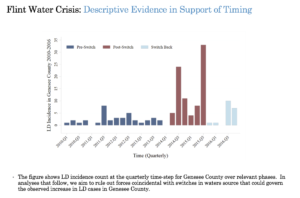Story by Jeff Dodge. Originally published on SOURCE.
At first glance, it seems like an unlikely pairing: How could economists conceivably help decipher what caused the public health crisis in Flint, Michigan, in 2014-15?
Statistical analysis, that’s how.
Sammy Zahran, an associate professor in Colorado State University’s Department of Economics, calls it “econometrics.” In a recent interview, he retraced the steps he and his coauthors took to determine that the outbreak of Legionnaires’ disease in Flint was caused by a change in the city’s water source.
Zahran was the lead author of an article about that conclusion published in the Proceedings of the National Academy of Science in February. CSU Economics Professor David Mushinski was a co-author.
About Legionnaires’ disease
Legionnaires’ disease, a severe type of pneumonia, is a relatively rare illness that is more prevalent in developing countries than in Flint, which might typically see a handful of cases in any given year, Zahran says. In this case, it sickened scores of people and was linked to the deaths of 12.
Flint, which had been buying Lake Huron water from the city of Detroit, switched its water supply to its backup source, the Flint River, in April 2014 to save money. The following August, Flint officials issued a water boiling advisory in response to tests showing there was coliform bacteria in the water.
But the city’s water source was not switched back to Detroit’s until October 2015, after elevated levels of lead were detected in the water — and local children. In his analysis, Zahran examined how the incidence of Legionnaires’ disease fluctuated across these moments.
He and Mushinski looked at all 833 cases of the disease that occurred in a three-county area in and around Flint from 2010 to 2016. They obtained patients’ addresses and the date they reported symptoms.
Photo by Marcin Szczepanski/University of Michigan
Establishing the cause
Zahran and Mushinski charted those figures and discovered that the incidence of Legionnaires’ spiked after Flint switched its water supply to the Flint River, before the water boiling advisory was issued. They found that the odds of getting the disease increased tenfold after the move was made.
The incidence of the disease then dipped some, to only about 5.8 times the average level, after the city’s advisory. Sales of bottled water went up, and water meter data shows that consumption went down, probably because people were reluctant to use the water even if it was boiled. But the incidence of Legionnaires’ did not return to historically normal levels until after the city returned to Detroit-supplied water, more than a year later.
“This is what economists can do with data,” Zahran says. “One can restitch the story with the power of statistics and econometrics. If you’re careful about finding the right analytical moments, you can detail out an autopsy of what happened and why.”
Zahran, left, and Mushinski discuss some of the equations they used in their analysis. Photo by Xavier Hadley/Colorado State University
A thorough process
Zahran and Mushinski were meticulous in their analysis, chronicling the incidence of the disease for thousands of neighborhoods, week by week, and comparing it to a control group outside the affected area. Zahran created a PowerPoint detailing his approach, including lengthy, dense statistical formulas. He controlled for variables that could affect the probability of Legionnaires’ appearing in a neighborhood in any given week, such as temperature, humidity and residents’ age and income level.
Zahran also charted chlorine levels in the water, because the local water treatment facility was adding extra chlorine to the Flint River water to combat its high levels of bacteria, he says. Zahran found that chlorine levels were all over the map when the city was using the alternate water source, and he suspects chloride was eating away at the inside of water pipes — releasing lead in some cases.
He established a correlation between the incidence of Legionnaires’ and chlorine levels: The lower the level of chlorine, the higher the odds of getting the disease, and vice versa.
Photo by Marcin Szczepanski/University of Michigan
He even tested a competing theory that the Legionnaires’ outbreak could have been caused by a contaminated water tower at a local hospital. In one exercise, Zahran removed all cases of the disease that could have been caused by water at the hospital. Even without those cases, his calculations still yielded a significantly higher probability of getting Legionnaires’ disease during the period that Flint River water was being used by the city.
Disease among commuters
Zahran and Mushinski also examined areas around Flint to see if commuters who were drinking Flint water during the day at work also had an elevated risk of contracting Legionnaires’ during that period. (The disease is not contagious and can’t be transferred from one person to another.) Indeed, locations with higher numbers of commuters also displayed a higher incidence of Legionnaires’.

Zahran says one takeaway from his team’s study was that public officials should take residents’ complaints seriously.
“Ultimately, this is a story about human beings,” Zahran says. “Within weeks of the water switch, people were complaining about the color and odor of the water, and they were largely ignored. If we had acted on the citizens’ reactions, we might have averted this situation.”
It’s also a story about how an unexpected department in the College of Liberal Arts — Economics — can lend its expertise to a public health crisis and other issues facing society.
“Economics can be used to solve real-world problems,” Zahran says. “It’s through these tools that we can see the sequence of events that led to this catastrophe.”
“This work illustrates the relevance and power of economics and econometrics in providing a toolset to model the lived experiences of individuals, thus extending beyond the classroom relationships between prices and quantities of economic goods,” said Anita Pena, chair of the Department of Economics. “These colleagues have embraced synergies across disciplinary boundaries in order to inform public health and policy, and to better understand impacts of environment on wellbeing.”



